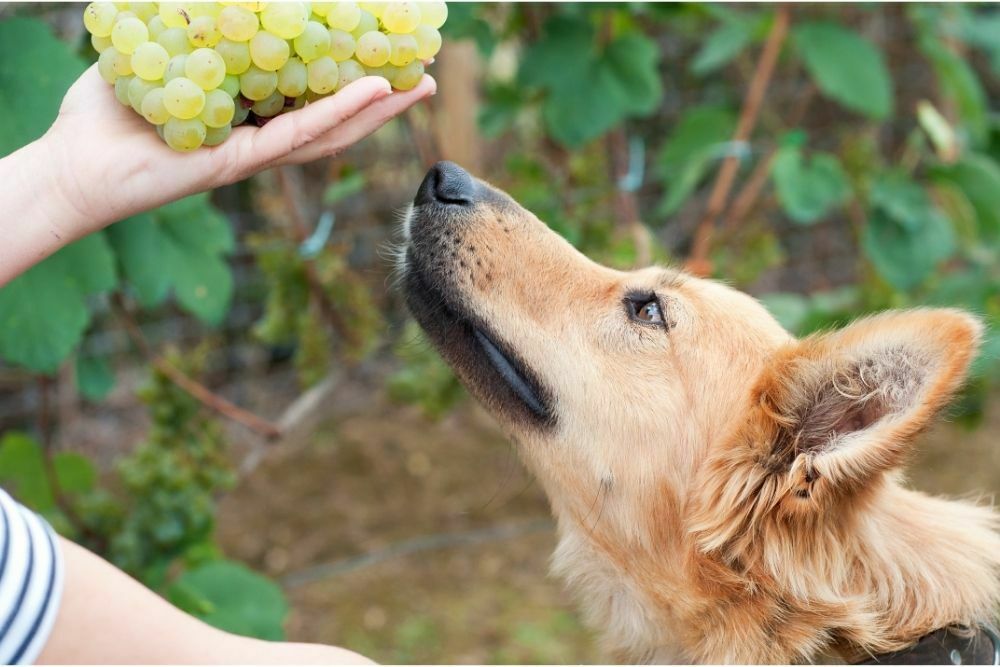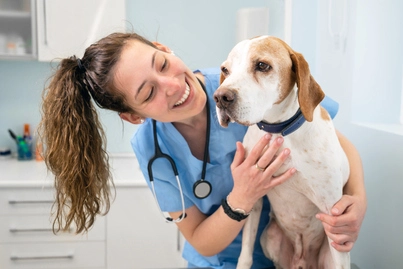A single grape can kill a dog, but this is unlikely. If your dog weighs under 10 pounds, ingesting a single grape is a real cause for concern. The larger your dog gets, the less likely it is that a single grape can be fatal. Regardless, grapes and raisins are very toxic to dogs, and you should never allow your dog to eat either.

The type of grape is irrelevant. Red, green, black, mass-produced, or grown in your backyard, all of them are incredibly harmful to your dog’s health. Many scientists have evaluated the components within grapes that make them so toxic to dogs.
Herbicides and pesticides have been linked to poor health, although these are not the main toxins. As of right now, we are still unaware of why grapes are so dangerous for dogs.
The only thing we know for sure is that the toxins are contained within the flesh of a grape instead of the seeds and skin. This has given rise to the theory that the toxin is a water-soluble substance.
Some experts believe that the toxin is a nephrotoxic mycotoxin – meaning a poison that is created by fungi on the grapes, which directly impacts the kidneys. This theory came about as the toxicity of grapes on dogs was first noticed after a year of heavy rainfall.
When the grapes are consistently damp, the levels of fungal growth are much higher. Dog kidney cells have been proven to be highly sensitive to mycotoxins, giving this theory strong circumstantial backing.
If your dog eats a grape, it can lead to the development of kidney failure. If left untreated, this can rapidly lead to death.
Connect with a verified veterinarian in minutes. No waiting for appointments or office hours. No high fees. Your pet's health made convenient and worry-free.
Can one grape kill a 30-pound dog?
No, a single grape is unlikely to be sufficient to kill a 30-pound dog. As a general rule, 1-2 grapes are toxic for a dog weighing approximately 10 pounds. For a 20-pound or heavier dog, 3-4 grapes tend to be toxic.
Other factors to consider include the age, gender, and health of your dog. These will all influence how dangerous the ingested grapes are. Some people believe that some dogs have a genetic variant that allows them to be more or less susceptible to the harmful effects of grape ingestion. This could explain why some dogs appear much less impacted by eating a grape than others.
That being said, you should take every precaution to ensure that your dog never has access to grapes. They should be kept well out of your dog’s reach and preferably in a fruit bowl or box.
As well as this, you should avoid any grape-containing products. This means that grape juice, jelly, wine, and sweets are all also off-limits for your dog. There is no evidence to suggest that the processing and manufacturing process helps reduce toxicity.

What should you do if your dog eats a grape?
The first thing that you should do is take your dog to a veterinarian. They will ask you some questions about the quantity of fruit that has been eaten and monitor your dog’s reaction. If you notice any of the following symptoms, you must seek immediate medical attention.
There are many symptoms that you can keep an eye out for following the ingestion of a grape. These will all be indicative of grape toxicity. They include an upset stomach, vomiting, diarrhea, loss of appetite, halitosis (bad breath), and abdominal pain.
You may also see your dog becoming suddenly hyperactive, or you could see them becoming lethargic and depressed. Your dog may refuse to drink and go for extended periods without urinating, leading to dehydration.
They may experience some tremors or breathing difficulty. In extreme cases, they may go into a state of kidney failure.
The veterinarian is likely to give your dog activated charcoal as an emetic. This is only used if it has been 2 hours or less since the grapes were eaten. This will make them vomit up the grapes or raisins before the stomach has had a chance to break down the fruits and absorb the toxins into the bloodstream.
They are likely to keep your dog in for monitoring for up to 4 days. In the first 48 hours, your dog is likely to be on intravenous fluids, and their blood chemistry panels will be checked over for at least 72 hours.
The veterinarian may also perform a variety of other tests, including urinalysis. They are likely to perform an ultrasound to check the size of your dog’s kidney and to look for mineral deposits. Following this, they may place your dog on a course of kidney medication.
Will one raisin kill a dog?
Again, this will depend on the weight of your dog. A dangerous level of raisins for a 10-pound dog is around 0.7 ounces. For a 20-pound dog, it will raise to 1.4 ounces, 2.1 ounces for a 30-pound dog, and 2.8 ounces for a 40-pound dog.
Many people believe that raisins are more dangerous to your dog than grapes. This is because they have been dehydrated, making them more concentrated.
From the research that has currently been conducted, it appears as though the toxins are not always present in raisins. This means that you may see your dog eating raisins and being fine on one occasion, but the same quantity of raisins may make them severely ill the next time.
There have been studies done on the effects of raisins and grapes on dogs. These have shown that in some cases, the quantity ingested is not the most important. Some dogs just seem to be luckier than others. There is not a clear-cut amount that will be toxic for dogs, but we recommend that you try to avoid them eating any.
If your dog has consumed any grapes or raisins, we strongly recommend seeking urgent medical advice. The ASPCA APCC (American Society for the Prevention of Cruelty to Animals Animal Poison Control Center) has a phone line open 24/7.

